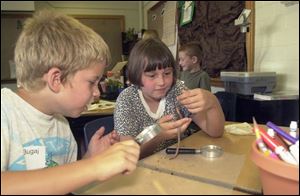
Innovative education: Teachers get look at experimental classroom
8/3/2001
`I think he likes me,' says Holly Davis as she and Tyler Bugaj, both 8, study a nightcrawler at St. Pius X School in a class designated as a model for integrated thematic instruction.
Cathy Barron greeted her pupils individually yesterday as they filed into the classroom at St. Pius X Catholic School, passing a sign that exclaimed, “It's going to be a great day!”
The hum of overhead fluorescent lights was notably absent as warm lamplight mingled with sunlight filtering through the windows at the school, 2950 Ilger Ave. The desks, usually arranged in neat rows, were clustered in groups of four, with a basket of supplies and a small plant as a centerpiece.
“It's different,” said 7-year-old Cameron Tafelski, a St. Catherine School pupil asked to participate in an experimental classroom for the Diocese of Toledo Model Teaching Week. “There's more stuff on the walls,” he said.
It's all part of a progressive learning philosophy called integrated thematic instruction, which applies modern brain research to the environment of learning, teaching strategies and curriculum development.
More than 100 teachers and administrators from area Catholic schools observed two experimental classrooms this week. Elementary-aged pupils studied earthworms and middle school-aged students studied electrical networks.
The teaching model has changed “just about everything” in Gayle Burrer's fourth-grade classroom at All Saints Catholic School in Rossford. Ms. Burrer has been a teacher for 10 years.
A nonthreatening, peaceful, and stress-free environment is crucial to learning, said Ann Ross, an instructor from Washington-based Susan Kovalik & Associates in charge of this week's workshop. Bright colors, for example, are unsettling, while natural colors create an environment more conducive to learning.
Lighting and noise-levels play an important role in setting an appropriate stage for learning. “The buzzing of the overhead lights really distracts some learners,” said Ms. Burrer, who tries to use as much natural light in her room as possible. Children with attention deficit-hyperactivity disorder are especially distracted by noisy fluorescent lights.
Clear expectations of pupils also influence a learning environment. The day's activities are posted in each class, and hallway procedures, water-fountain procedures, and cafeteria rules are posted throughout the school.
In addition to the environment of the classroom, teaching techniques also are changing. “I try not to lecture for more than 10 minutes at a time,” Ms. Burrer said.
Ms. Burrer tries to involve movement during learning, as well. When teaching Maslov's hierarchy of needs, she associated movements with each need, such as pretending to chew noisily to represent the need for food and nutrition.
Pupils would use the movements to help recall the information during tests, Ms. Burrer said.
The Diocese of Toledo hired Susan Kovalik & Associates six years ago to help schools begin implementing the integrated thematic instruction model.
Officials said pupils are scoring higher on standardized tests, although the results cannot be directly linked to the changes.